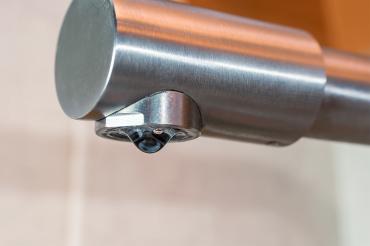'Too comfortable in our own comfort': U of T expert on why we shouldn’t waste water

Published: March 29, 2023
It’s common knowledge that reducing our carbon footprint is important, but what about our water footprint?
Showering, cooking, doing dishes and flushing toilets adds up fast, and Canadians use more than 215 litres each day.

Mandy Meriano
“We need to ask more questions about our water, where that water comes from and how it gets to us,” says Mandy Meriano, associate professor, teaching stream, in the department of physical and environmental sciences at the University of Toronto Scarborough.
“Sometimes I think we're a bit too comfortable in our own comfort.”
In Ontario, much of our water comes from the Great Lakes, which contain about 20 per cent of the world’s supply of fresh water found above ground.
Meriano says one important reason to conserve is the unnecessary wear it puts on the vast filtration and delivery systems that get potable water to your tap. It’s a labour-intensive process relying on infrastructure that will eventually need replacing and may include fossil fuel use for transportation. Just like tossing food in the trash, wasting water adds to the demand we place on the environment, Meriano says.
It’s not just end users that are the issue. Meriano conducted a study in Pickering, Ont., that found when treated water was sent into distribution systems, as much as 14 per cent leaked out of water mains and into the ground, contributing to local flood risks and the formation of sink holes.
“We all have an individual responsibility, but I think at a greater level, too, the government has to start paying attention,” she says. “We need to be engaged with how people that we put in government are actually managing, or mismanaging, our resources.”
Meriano says those looking to reduce their water footprint should start at home and share their knowledge.
“Once you learn something, pass it on. If you tell another person and you motivate them to make a change and be positive and upbeat about it, it's important,” she says. “I deeply believe in that snowball effect. You can gain that momentum.”
For example, she says she’s picked up some water-saving habits from her students – including one from Australia who took extremely quick showers due to routine water shortages and another who reused water from washing vegetables to water plants. She also notes that some of her students come from countries where water is frequently contaminated, reminding her of her water privilege.
Steps to reduce your water footprint
Meriano offers the following tips for saving water inside and outside the home:
- Fix leakages or dripping immediately from toilets, hot water heaters or other pipes and make sure to turn taps off all the way.
- Showers use less water than baths but if you need to take a soak, don’t fill the tub all the way.
- When opportunity arises, choose a new washing machine, toilet, showerhead or dishwasher that uses less water.
- Rainwater that flows down gutters can be collected and used to water plants and gardens.
- Water lawns when it’s not hot so water doesn’t evaporate, and don’t water them on windy days.
- Keeping blades of grass longer can also shelter the roots and cause lawns to need less water.
Those looking to take it a step further can look at donating to charities dedicated to conservation, Meriano says, and remember “you can also give yourself.” Volunteering can include offering an organization your time, knowledge or skillset.
In Meriano’s case, she used her background as an educator and funding from the Bill and Melinda Gates Foundation to put together a master’s program training graduates in water resources management at universities in sub-Saharan Africa.
“All health is reliant and dependent on clean water,” she says. “You can't have healthy populations without having access to clean water.”



